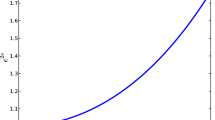Abstract
Using isentropic and homogeneous stellar models the final stages of stellar evolution are discussed. These primitive models are a natural generalization of polytropic models to cases of complex equations of state. The equations of state used in the present work include the effects of radiation, quantum degeneracy, relativistic electrons and pairs, and of a Fe-He transition.
A limiting mass-entropy relation is discussed. This relation is a direct generalization of Chandrasekhar's limiting mass for white dwarfs, and is useful for obtaining a general picture of the evolutionary tracks at late stages.
Tracks of central conditions on thep, T plane are calculated for isentropic models and the occurrence of various instabilities is discussed.
Similar content being viewed by others
References
Arnett, W. D.: 1966, Ph.D. Thesis, Yale University.
Barkat, Z., Rakavy, G., andSack, N. 1967,Phys. Rev. Letters 18, 379.
Chandrasekhar, S.: 1939,An Introduction to the Study of Stellar Structure. University of Chicago Press, Chicago.
Chiu, H-Y.: 1966, inStellar Evolution (ed. by R.F. Stein and A.G.W. Cameron). Plenum Press, New York, pp. 279.
Colgate, S. A. andWhite, R. H.: 1966,Astrophys. J. 143, 626.
Fowler, W. A. andHoyle, F.: 1964,Astrophys. J. Suppl. 91, 9, 201.
Frank-Kamenetskii, D. A.: 1962,Physical Processes in Stellar Interiors (translated from the Russian). Israel Program for Science Translations, Jerusalem.
Hamada, T. andSalpeter, E. E.: 1961,Astrophys. J. 134, 683.
Hoyle, F. andFowler, W. A.: 1960,Astrophys. J. 132, 565.
Landau, L. D.: 1932, (cf.Landau, L. D. andLifschitz, E. M., 1958),Statistical Physics. Addison-Wesley, Reading, Mass.
Ledoux, P.: 1965, inStars and Stellar Systems, vol. VIII. University of Chicago Press, Chicago, p. 527 (and further references therein).
Rakavy, G. andShaviv, G.: 1967,Astrophys. J. 148, 803.
Rakavy, G., Shaviv, G., andZinamon, Z., 1967,Astrophys. J. 150, 131.
Weigert, A.: 1966,Z. Astrophys. 64, 395.
Author information
Authors and Affiliations
Additional information
Supported in part by the National Science Foundation [GP-7976] formerly [GP-5391] and the Office of Naval Research [Nonr-220 (47)].
Rights and permissions
About this article
Cite this article
Rakavy, G., Shaviv, G. Isentropic models for final stages of stellar evolution. Astrophys Space Sci 1, 429–441 (1968). https://doi.org/10.1007/BF00658767
Received:
Published:
Issue Date:
DOI: https://doi.org/10.1007/BF00658767



